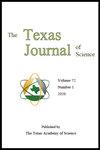德克萨斯州东部一个小溪流系统中鳄龟的运动模式、家园范围和微生境使用情况
Q4 Agricultural and Biological Sciences
引用次数: 0
摘要
鳄鱼鳄龟(Macrochelys temminckii)是北美洲最大的淡水龟,面临着众多威胁,其种群数量下降和分布范围缩小的情况疑似已在其历史分布区内出现。以前对M. temminckii的运动模式和微生境利用的研究大多是在大型、开阔、湖泊环境中进行的,很少有在小型、地段生境中进行的研究。我们在得克萨斯州东部安吉丽娜河的一条小支流博纳多溪(Bonaldo Creek)中调查了雌性成年模板栉水母(M. temminckii)和幼年模板栉水母(M. temminckii)的移动和微生境利用情况。从 2008 年 7 月到 2009 年 9 月,我们通过无线电遥测技术监测了六只 M. temminckii(每周迁移两到三次)。我们发现,成年雌性的线性家庭活动范围(405.1-1395.5 米)长于未绝育幼体(439.7-996.9 米),但两组之间的活动频率相似。与成年雌鱼相比,幼鱼利用的微生境较少。成年雌鱼利用具有丰富水下结构的微生境,而悬垂植被是幼鱼的重要微生境特征。我们在成年雌鱼身上观察到的更广泛的微生境利用可能受到了季节性因素的影响,这凸显了对M. temminckii的运动和微生境进行更长期的季节性评估的必要性。这些调查将有助于我们了解影响不同系统中M. temminckii种群的空间和时间因素。本文章由计算机程序翻译,如有差异,请以英文原文为准。
MOVEMENT PATTERNS, HOME RANGE, AND MICROHABITAT USE OF ALLIGATOR SNAPPING TURTLES (MACROCHELYS TEMMINCKII) IN A SMALL EAST TEXAS STREAM SYSTEM
The alligator snapping turtle (Macrochelys temminckii), the largest freshwater turtle in North America, faces numerous threats, with population declines and range contractions suspected to have occurred across its historic range. Previous research studying movement patterns and microhabitat use of M. temminckii has mostly been conducted in large, open, lentic environments and few studies have been conducted in small, lotic habitats. We investigated the movement and microhabitat use of adult female and juvenile M. temminckii within Bonaldo Creek, a small tributary of the Angelina River in eastern Texas. Six M. temminckii were monitored (two or three relocations per week) via radiotelemetry from July 2008 to September 2009. We found that the linear home range for adult females (405.1–1395.5 m) was longer than that of the unsexed juveniles (439.7–996.9 m), although movement frequency was similar between groups. Juveniles utilized a smaller subset of microhabitats compared to adult females. Adult females utilized microhabitats with abundant submerged structure, while overhanging vegetation was an important microhabitat feature for juveniles. The broader microhabitat use we observed in adult females may have been influenced by seasonal factors, highlighting the need for more long-term, seasonal assessments of M. temminckii movement and microhabitat. Such investigations will bolster our understanding of the spatial and temporal factors that influence M. temminckii populations in different systems.
求助全文
通过发布文献求助,成功后即可免费获取论文全文。
去求助
来源期刊

The Texas Journal of Science
Agricultural and Biological Sciences-Ecology, Evolution, Behavior and Systematics
CiteScore
0.50
自引率
0.00%
发文量
2
期刊介绍:
Scholarly manuscripts reporting original research results in any field of science or technology, including science education, will be considered for publication in The Texas Journal of Science. Prior to acceptance, each manuscript will be reviewed by both knowledgeable peers and the editorial staff. Authors are encouraged to suggest the names and addresses of two potential reviewers to the Manuscript Editor at the time of submission of their manuscript.
 求助内容:
求助内容: 应助结果提醒方式:
应助结果提醒方式:


